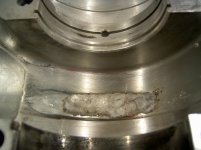pistonskirt
Hot Rolled
- Joined
- May 9, 2004
- Location
- Plymouth, Devon, England
Part to be repaired is a Japanese motorcycle crank case manufactured around year 2000, this is sand cast aluminium of very good quality but unknown composition though I assume fairly high silicon content.
Unfortunately some Herbert went at it like the proverbial bull in the china shop & there is a large crack alongside the full length of the inside angle & across to the culprit weld.
The casing is water cooled beneath the area in question so I have no access from behind, my intention is to machine out the damaged area to the extent of the cracks & machine up a semi circular patch plate from suitable bar stock & weld in. I do have experience in this type of repair so am familiar with techniques to minimize distortion etc all of which will be employed in my attempt, nonetheless experienced comment would be welcomed.
My question is ..... what grade of aluminium bar stock might be compatible with the casting in terms of composition & thermal properties, weldability will be important as I certainly need to minimize the weld lapping up the heavier section vertical side of the inner corner.
regards
Brian
Unfortunately some Herbert went at it like the proverbial bull in the china shop & there is a large crack alongside the full length of the inside angle & across to the culprit weld.
The casing is water cooled beneath the area in question so I have no access from behind, my intention is to machine out the damaged area to the extent of the cracks & machine up a semi circular patch plate from suitable bar stock & weld in. I do have experience in this type of repair so am familiar with techniques to minimize distortion etc all of which will be employed in my attempt, nonetheless experienced comment would be welcomed.
My question is ..... what grade of aluminium bar stock might be compatible with the casting in terms of composition & thermal properties, weldability will be important as I certainly need to minimize the weld lapping up the heavier section vertical side of the inner corner.
regards
Brian





 makes very good sense & I will do some experimenting.
makes very good sense & I will do some experimenting.